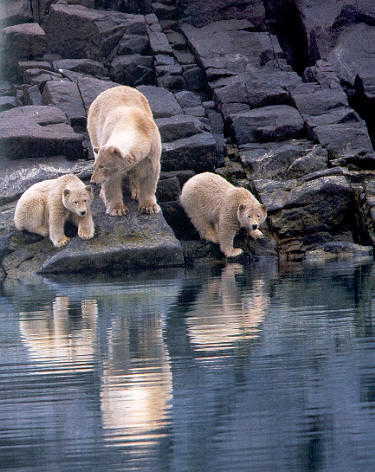1. Polar bears aren’t white
A polar bear’s skin is black and its fur is transparent with a hollow core that reflects and refracts light from the sun and off the snow, making it appear white. This adaptation helps polar bears keep warm as their fur reflects heat from the sun down the hair shaft so that it can be absorbed by their black skin.
2. Polar bears are marine mammals
Although polar bears spend a lot of time on land, they are perfectly suited for life in the ocean. Their snout, head and body are longer and more streamlined than other bears, allowing them to swim more efficiently. Their large wide paws act as paddles to propel them through the water and their hind paws act as rudders helping them steer.
3. Polar bears are the largest land carnivore
Male polar bears can grow up to 2.8 metres long and 800 kilograms in weight. Although this is the larger end of the spectrum, on average, polar bears are still considered to be the biggest bear, rivaled only by Kodiaks, a subspecies of the brown bear that is native to Alaska.
4. Polar bears are tiny and helpless at birth
Although polar bears grow to be huge, they start their life extremely small and helpless. When born, cubs are blind, toothless and covered in a sparse layer of soft, short fur. Newborn cubs are only about 25 centimeters long and weigh around one kilogram, but they grow rapidly thanks to their mother’s rich milk which is approximately 31 per cent fat.
5. Polar bears typically give birth to twins
Although polar bears can give birth to one to three cubs, they most commonly give birth to twins. This evolutionary adaptation increases the likelihood that at least one cub will survive to adulthood, especially given the harsh and unforgiving conditions found in their Arctic habitat.
6. Polar bears need sea ice
Polar bears are dependent on sea ice to catch seals, as they are most efficient as ambush hunters. They catch seals by waiting for them to surface at their breathing holes in the ice, stalking them sunbathing on the sea ice, and by breaking into the birthing chambers of ringed seals. These skills are invaluable to a polar bear’s survival and inherently make them heavily reliant on sea ice.
7. Polar bears have perfectly adapted paws
The bottom of a polar bear’s footpads are covered by small bumps, called papillae, which help them to grip the ice and avoid slipping. The tufts of fur between their toes also help with this task, making them “slip resistant.” Polar bears also have extremely thick, sharp and strong claws, which they can use to help gain further traction when walking on ice.
8. Polar bears are mostly Canadian
There are 19 subpopulations of polar bears in the world, which are based on geographic sea-ice regions. Thirteen of these subpopulations, which makes up about 60 per cent of the global polar bear population, can be found in Canada.
9. Polar bears can fast for up to eight months
When the summer rolls around and sea ice retreats, polar bears head towards land to live out the ice free season. During this time, they can go for long periods without eating, surviving mostly off of the fat stores they accumulated over the winter by eating seal blubber. However, the longest fasts among polar bears are seen by females, who can go four to eight months without eating; from the time they enter their den to give birth, to the time they emerge from the den and arrive at the ice edge the following spring.
10. Polar bears are called “Nanuq” in Inuktitut
The word Nanuq, which is Inuktitut for polar bear, means an animal worthy of great respect, or the ever wandering one. Polar bears hold great spiritual and cultural significance for Inuit communities.
https://www.oceana.ca//en/blog...8xHl0JkueVLlf2cLiQZL
